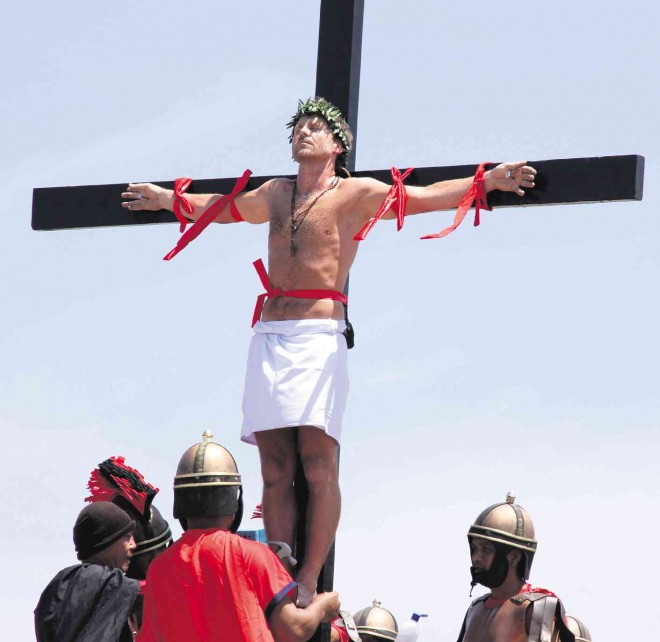
NO ROLE PLAYING Danish filmmaker Lasse Spang Olsen steals the limelight after being nailed to the cross in Barangay San Pedro Cutud in San Fernando, Pampanga province, on Good Friday in 2014. Olsen, 49, could be the last foreign national to take part in the reenactment of the crucifixion of Christ after local officials banned foreigners from participating in the annual Holy Week rites. E.I. REYMOND T. OREJAS/ CONTRIBUTOR
CITY OF SAN FERNANDO—For the safety of everyone, city officials are making Good Friday crucifixions in three villages here a strictly Filipino affair—and for true penitents only.
Councilor Harvey Quiwa, cochair of the Malelo (Holy Week) 2015 Committee, said on Monday that a ban on the crucifixion of foreigners covered the neighboring villages of San Pedro Cutud, Santa Lucia and San Juan.
The crucifixion of foreigners was also prohibited last year, but Danish filmmaker Lasse Spang Olsen managed to join 11 Filipino men who had themselves nailed to crosses in the annual rites for the atonement of sins, seeking favors from God and giving thanks for answered prayers.
The village council of San Pedro Cutud allowed Olsen to join the rites after he claimed that he had been converted to Roman Catholicism.
Local officials said the ban on foreign participation had been prompted by the disrespect for the local Lenten tradition shown by some foreigners.
In 2008, a Briton made a scene before backing out at the last minute, they said.
Once, a Japanese man used the footage of his crucifixion as an insert in a pornographic film, they said.
The tradition began in 1962, with faith healer Artemio Anoza having himself crucified in San Pedro Cutud on Good Friday.
But live scenes from the Passion of Christ were no longer new in the village by that time.
In 1955, poet-playwright Ricardo Navarro staged the play “Via Crucis” (“Way of the Cross”) on the streets of the village.
Other penitents followed Anoza’s example, and soon crucifixions became a regular Good Friday event in this city.
Multiple crucifixions
The most popular site for crucifixions is San Pedro Cutud, 3 kilometers from the city center, where a dozen or so penitents—always men, although women are not disallowed from the rites—are taken to a rice field on Good Friday to be nailed to wooden crosses using stainless steel nails that have been disinfected with alcohol.
A Passion play precedes the crucifixions.
Other penitents roam the streets flogging themselves with whips tipped with thin strips of bamboo.
The Good Friday event has been drawing foreign tourists to the City of San Fernando every year, with some foreigners trying the crucifixion experience.
But the bad experience with foreign participation has prompted local authorities to limit the event to Filipinos who are true penitents.
Susan Dizon, treasurer of San Pedro Cutud, said the village council will not allow foreigners to apply for permits to be crucified on Good Friday.
Among those who have been shut out of this year’s rites is an Iranian who has converted to Catholicism after living in the Philippines for 35 years, said Ruben Enaje, who will be nailed to a cross for the 30th time on Good Friday since his first time in 1985.
Waiver
Local penitents need to sign a waiver clearing the village council of any responsibility for anything that may happen to them as a result of being crucified.
San Fernando Mayor Edwin Santiago said the regulations were necessary to ensure the safety of all.
Santiago said about 60,000 visitors were expected to come to San Pedro Cutud alone on Good Friday.
The city police said 300 officers would be deployed to the village to keep order.
Quiwa said the practice of crucifixion as a form of penance had spread to the villages of San Nicolas and San Jose and in Northville, a resettlement site for informal settlers along the old Philippine National Railways tracks.
The Catholic Church does not approve of the Good Friday crucifixions. It does not recommend crucifixion as a form of penance.
Free Wi-Fi on ‘Calvary’
This year, the “Calvary” that has been carved from hardened Mt. Pinatubo sediment in San Pedro Cutud’s Purok Kuatro will be a free Wi-Fi area on Good Friday, courtesy of Smart Communications, according to Roland Sunga, the company’s area manager.